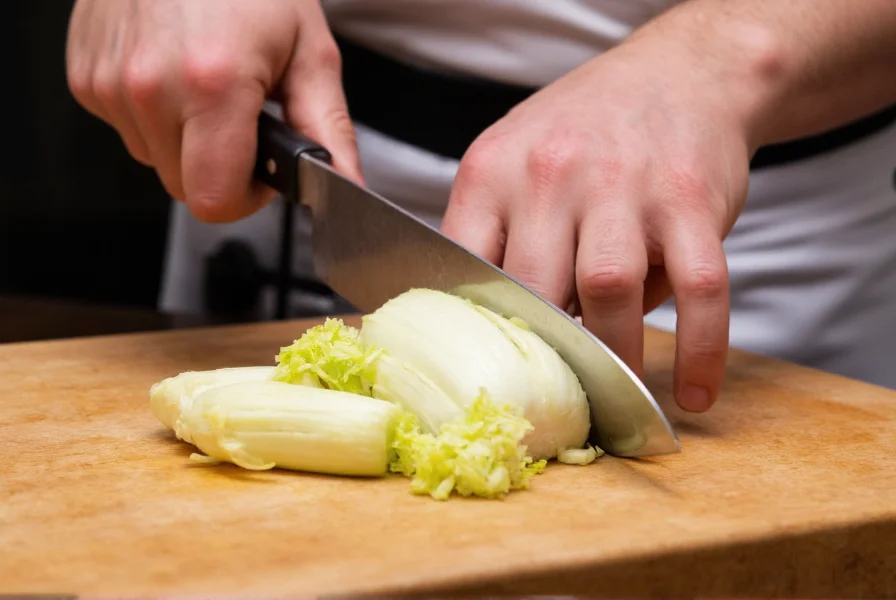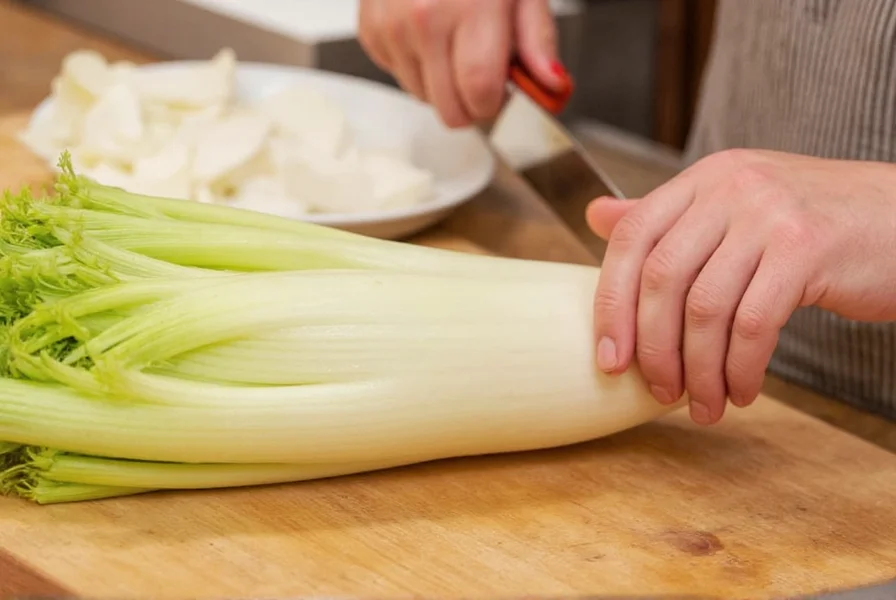Mastering fennel preparation transforms this aromatic vegetable from intimidating to indispensable in your kitchen. Many home cooks struggle with fennel's unique structure, leading to wasted produce or uneven cooking. Proper cutting techniques maximize fennel's sweet-anise flavor while maintaining its crisp texture through various cooking methods.
Essential Tools for Cutting Fennel
Before handling fennel, gather these kitchen essentials:
- Sharp 8-inch chef's knife (dull blades crush fennel fibers)
- Stable cutting board (wood or composite)
- Vegetable peeler (for tough outer layers)
- Small bowl of cold water (prevents browning)

Step-by-Step Fennel Preparation Guide
Fresh fennel requires specific handling to preserve its delicate crunch and aromatic qualities. Follow these professional techniques:
1. Initial Trimming
Place the fennel bulb on your cutting board with the root end facing away from you. Using a sharp knife, cut 1 inch above the bulb to remove leafy stalks. Reserve fronds for garnish—they're edible and flavorful. Next, slice 1/4 inch from the root end, keeping it intact for stability during further cutting.
2. Removing Outer Layers
Peel away any discolored or tough outer layers with your fingers or vegetable peeler. Fresh fennel should reveal crisp, pale white layers beneath. For older bulbs with fibrous exterior, remove 2-3 layers until reaching tender flesh.
| Cutting Technique | Best For | Knife Angle |
|---|---|---|
| Thin crosswise slices | Salads, slaws | 90 degrees to bulb |
| Wedges with root intact | Roasting, grilling | Radial cuts from center |
| Julienne strips | Stir-fries, garnishes | Parallel then perpendicular |
3. Precision Cutting Methods
For salads: Stand the bulb upright and slice crosswise into 1/8-inch thin rounds. The uniform thickness ensures even marination and crisp texture in dishes like fennel and orange salad.
For roasting: Cut vertically through the root end into quarters. Keeping the root intact prevents wedges from falling apart during cooking. This technique for cutting fennel bulb properly maintains structural integrity while allowing even caramelization.
For soups and stews: Dice into 1/2-inch cubes after removing the tough core. Smaller pieces distribute flavor throughout the dish while maintaining distinct fennel notes.

Advanced Fennel Preparation Tips
Professional chefs employ these specialized techniques when working with fennel:
Core Removal for Stuffing
To prepare fennel for stuffing, use a small paring knife to carefully cut around the tough core in a conical shape, creating a cavity while preserving the bulb's structure. This method for hollowing fennel maintains its shape during baking while allowing fillings to penetrate.
Preventing Oxidation
Fennel doesn't brown as quickly as apples or potatoes, but for extended preparation times, submerge cut pieces in ice water with lemon juice (1 tablespoon per cup). This preserves crispness without waterlogging the vegetable—a crucial step when preparing fennel in advance for catering events.
Utilizing the Entire Plant
Don't discard any part of the fennel plant. The feathery fronds make excellent garnish or can be finely chopped for salads. Thick stalks work well in stocks, while the bulb forms the culinary foundation. Understanding how to cut fennel completely minimizes waste and maximizes flavor potential.
Common Cutting Mistakes to Avoid
Even experienced cooks make these errors when preparing fennel:
- Using a serrated knife - crushes delicate fibers instead of making clean cuts
- Removing the root completely - causes wedges to fall apart during cooking
- Cutting too thick for raw applications - results in tough, fibrous bites in salads
- Not trimming enough outer layers - leaves bitter, tough portions in finished dishes
Storage Guidelines for Cut Fennel
Properly stored cut fennel maintains freshness for 3-5 days. Wrap in slightly damp paper towels and place in airtight container in the refrigerator's crisper drawer. For longer storage, blanch slices for 90 seconds and freeze in single layers before transferring to freezer bags. This technique for preserving cut fennel prevents freezer burn while maintaining texture.
How Cutting Technique Affects Cooking Results
The way you cut fennel directly impacts flavor release and texture in finished dishes. Thin slices for fennel salad preparation expose more surface area, allowing quicker flavor absorption from dressings. Larger wedges for roasting caramelize slowly, developing deeper sweetness while retaining structural integrity. Understanding these relationships between cutting methods and cooking outcomes helps you choose the best preparation technique for each recipe.
Frequently Asked Questions
What's the best knife for cutting fennel?
An 8-inch chef's knife with a sharp, straight edge works best for cutting fennel. The length provides leverage for clean cuts through the dense bulb while the sharp edge prevents crushing the delicate fibers. Avoid serrated knives as they tear rather than slice the vegetable.
Should I remove the core when cutting fennel?
For most applications, leave the core intact as it holds wedges together during cooking. When making salads or slaws, you can remove the tough central core after slicing. For stuffing preparations, carefully hollow around the core while preserving the bulb's structure.
How thin should fennel be sliced for salads?
For optimal texture in salads, slice fennel crosswise into 1/8-inch thin rounds. This thickness provides enough substance to maintain crunch while allowing dressings to penetrate. Thicker slices can be fibrous and difficult to eat raw.
Can you eat fennel fronds?
Yes, fennel fronds are completely edible and flavorful. Use them as a garnish, chop finely for salads, or incorporate into pesto. They have a more intense anise flavor than the bulb and work well in fish dishes and vegetable preparations.
Why does my cut fennel become slimy?
Cut fennel becomes slimy when stored improperly in airtight containers without paper towels to absorb moisture. Always wrap cut fennel in slightly damp paper towels before placing in containers. This technique for storing cut fennel maintains optimal humidity levels without creating a wet environment that promotes spoilage.











 浙公网安备
33010002000092号
浙公网安备
33010002000092号 浙B2-20120091-4
浙B2-20120091-4